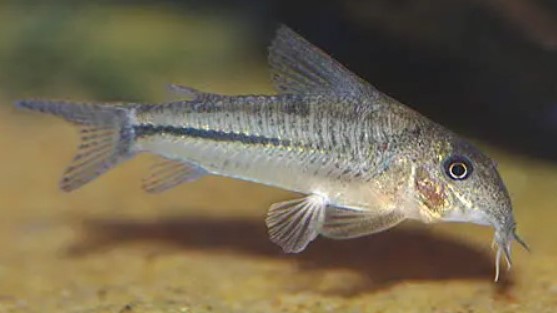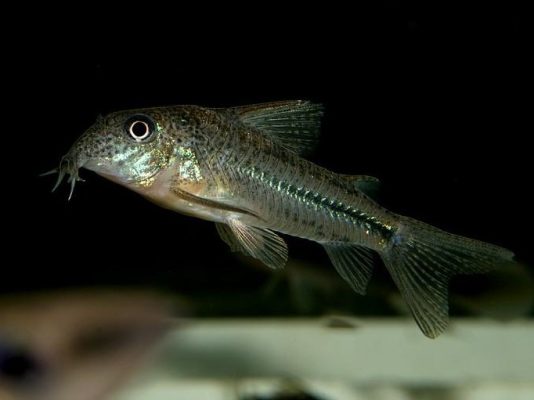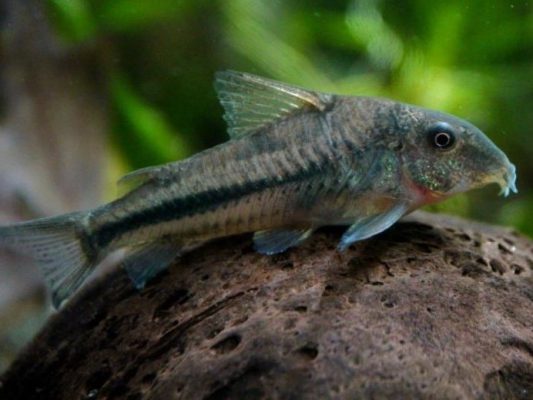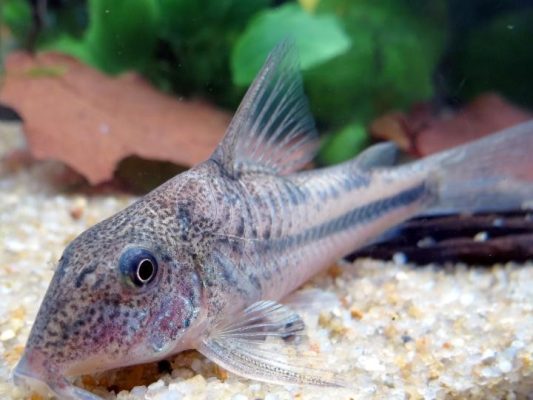Scleromystax Prionotos

Table of Contents
- Introduction
- Taxonomy and Physical Characteristics
- Taxonomy and Physical Characteristics
- Habitat and Distribution
- Behavior and Adaptations
- Reproduction and Life Cycle
- Research and Scientific Studies
Introduction
Scleromystax prionotos, commonly known as the Dwarf Corydoras or the Pygmy Corydoras, is a small species of catfish that belongs to the Callichthyidae family. This species is highly regarded among freshwater catfish enthusiasts due to its unique characteristics and captivating appearance.
The common names of Scleromystax prionotos, such as Dwarf Corydoras or Pygmy Corydoras, are widely recognized and used by both hobbyists and researchers in the field. These names not only reflect the small size of this species but also highlight its popularity and significance in the aquarium trade.
Understanding the habitat, behavior, and characteristics of Scleromystax prionotos is crucial for several reasons. Firstly, it allows us to gain insights into the natural environment in which this species thrives, enabling us to recreate suitable conditions for its captive care. Secondly, studying the behavior of Scleromystax prionotos provides valuable information about its social dynamics, feeding habits, and reproductive strategies. Lastly, comprehending the unique characteristics of this species contributes to our overall knowledge of catfish diversity and evolution.
By delving into the specifics of Scleromystax prionotos, we can uncover fascinating details about its taxonomy, physical characteristics, habitat, behavior, reproduction, conservation status, and ongoing research. This comprehensive exploration will not only shed light on the intricate aspects of this species but also highlight the need for its conservation and further scientific investigation.
Taxonomy and Physical Characteristics
Scleromystax prionotos belongs to the Callichthyidae family, which comprises a diverse group of armored catfish commonly found in South America. Within this family, Scleromystax prionotos is classified under the genus Scleromystax, which includes several other species with similar characteristics. The specific epithet “prionotos” is derived from the Greek words “prion” meaning saw and “notos” meaning back, referring to the serrated appearance of its dorsal fin.
Description of its physical appearance, including size and unique features
Scleromystax prionotos is a small-sized catfish, typically reaching a maximum length of around 3 centimeters (1.2 inches). Its body is elongated and laterally compressed, with a distinctive coloration pattern consisting of a light beige or cream base color adorned with dark brown or black spots. These spots are irregularly distributed along the body, giving it a striking and visually appealing appearance.
One of the most remarkable features of Scleromystax prionotos is its dorsal fin, which is adorned with sharp serrations resembling the teeth of a saw. This unique adaptation serves as a defense mechanism, deterring potential predators and providing stability during swimming. Additionally, like other catfish species, Scleromystax prionotos possesses barbels around its mouth, which aid in locating food and navigating its environment.
Comparison with other related catfish species
Within the Callichthyidae family, Scleromystax prionotos shares similarities with other catfish species, particularly those belonging to the Corydoras genus. However, it can be distinguished from its relatives by its smaller size, distinct coloration pattern, and the serrated appearance of its dorsal fin. These distinguishing features make Scleromystax prionotos a unique and sought-after species among catfish enthusiasts.
By examining the taxonomy and physical characteristics of Scleromystax prionotos, we gain a deeper understanding of its evolutionary history and ecological niche. This knowledge serves as a foundation for further exploration of its habitat, behavior, and conservation status, which will be discussed in subsequent sections.
Taxonomy and Physical Characteristics
Classification and scientific name of Scleromystax prionotos
Scleromystax prionotos, commonly known as the “dwarf hard-nosed catfish,” belongs to the family Callichthyidae and the genus Scleromystax. It was first described by the renowned ichthyologist Dr. Franz Steindachner in 1877. The species name “prionotos” is derived from the Greek words “prion” meaning saw, and “notos” meaning back, referring to the serrated appearance of its dorsal fin.
Description of its physical appearance, including size and unique features
Scleromystax prionotos exhibits a distinct and captivating physical appearance. It has a slender body with a maximum recorded length of approximately 6 centimeters (2.4 inches). The body is covered in small, overlapping bony plates called scutes, providing protection against potential predators. These scutes give the species a unique armored appearance, making it a fascinating sight for aquarium enthusiasts.
The coloration of Scleromystax prionotos is predominantly light brown or olive, with darker brown or black spots scattered across its body. These spots vary in size and shape, creating a beautiful pattern that aids in camouflage within its natural habitat. The ventral side of the fish is typically lighter in color, providing a contrast to the darker dorsal side.
One of the most striking features of Scleromystax prionotos is its distinctive head shape. The species possesses a short, rounded snout, which is believed to be an adaptation for foraging in the leaf litter and crevices of its habitat. Its eyes are relatively large and positioned laterally, allowing for a wide field of vision to detect potential threats or prey.
Comparison with other related catfish species
Within the Callichthyidae family, Scleromystax prionotos shares similarities with other catfish species, particularly those in the genus Corydoras. Both genera exhibit a similar body shape and possess the characteristic scutes that provide protection. However, there are notable differences that distinguish Scleromystax prionotos from its relatives.
One key distinction is the shape of the head. While Corydoras species have a more elongated snout, Scleromystax prionotos possesses a shorter, more rounded snout. This difference in head shape is believed to be an adaptation to their respective feeding habits and preferred habitats.
Additionally, Scleromystax prionotos has a more slender body compared to many Corydoras species, which tend to have a stockier build. This difference in body shape may be attributed to variations in their natural habitats and ecological niches.
While both Scleromystax prionotos and Corydoras species exhibit similar coloration patterns, the specific arrangement and intensity of spots can vary, allowing for visual differentiation between the two genera.
In conclusion, Scleromystax prionotos, with its unique physical characteristics and taxonomic classification, stands out among freshwater catfish species. Its slender body, armored appearance, and distinct head shape contribute to its captivating allure. Understanding the taxonomy and physical characteristics of this species is crucial for further research, conservation efforts, and appreciation of its ecological significance.
Habitat and Distribution
Geographic Range of Scleromystax prionotos, Focusing on Coastal Rivers in South America
Scleromystax prionotos, commonly known as the “dwarf armored catfish” or “prionotos catfish,” is native to the coastal rivers of South America. Its distribution spans several countries, including Brazil, Argentina, and Uruguay. However, it is most commonly found in the coastal regions of Brazil, particularly in the states of Espírito Santo and São Paulo.
Detailed Description of Its Preferred Habitat, Including Specific Regions such as Espírito Santo and São Paulo in Brazil
Within its geographic range, Scleromystax prionotos exhibits a preference for specific habitats that provide the necessary conditions for its survival and reproduction. It is primarily found in slow-moving or stagnant freshwater bodies, such as streams, rivers, and small ponds. These habitats often feature dense vegetation, submerged logs, and rocky substrates.
In the state of Espírito Santo, Scleromystax prionotos can be observed in the coastal rivers and their tributaries, particularly those with a higher concentration of vegetation. The species is known to inhabit the Rio Doce basin, which is characterized by its diverse aquatic plant life and abundant food sources.
Similarly, in the state of São Paulo, the prionotos catfish can be found in various river systems, including the Tietê, Paraíba do Sul, and Ribeira do Iguape rivers. These rivers offer a suitable habitat for the species, with their slow-flowing sections, submerged vegetation, and rocky substrates providing ample hiding places and foraging opportunities.
Factors Influencing Its Distribution, Such as Climate, Water Conditions, and Vegetation
The distribution of Scleromystax prionotos is influenced by several factors, including climate, water conditions, and vegetation. This species is most commonly found in regions with a tropical or subtropical climate, where temperatures remain relatively warm throughout the year. The coastal regions of South America, including Espírito Santo and São Paulo, provide the ideal climate for the prionotos catfish to thrive.
Water conditions also play a crucial role in determining the distribution of Scleromystax prionotos. The species prefers clean, well-oxygenated water with a neutral to slightly acidic pH. It is often found in areas with low turbidity and moderate current flow. Additionally, the presence of submerged vegetation, such as aquatic plants and fallen logs, is essential for providing shelter and food sources for the catfish.
The availability of suitable vegetation is a key factor in the distribution of Scleromystax prionotos. The species relies on the presence of dense aquatic vegetation for protection, foraging, and reproduction. These plants provide hiding places for the catfish and serve as a source of food, attracting benthic crustaceans and insects that form a significant part of its diet.
In conclusion, Scleromystax prionotos is primarily distributed in the coastal rivers of South America, with a particular focus on the states of Espírito Santo and São Paulo in Brazil. Its preferred habitat consists of slow-moving or stagnant freshwater bodies with dense vegetation, submerged logs, and rocky substrates. The species’ distribution is influenced by factors such as climate, water conditions, and the availability of suitable vegetation. Understanding these factors is crucial for the conservation and management of this unique freshwater catfish species.
Behavior and Adaptations
Feeding habits and diet of Scleromystax prionotos, including benthic crustaceans, insects, and plant matter
Scleromystax prionotos, commonly known as the “Dwarf Corydoras,” exhibits a diverse and interesting feeding behavior. This species is primarily omnivorous, consuming a variety of food sources to meet its nutritional needs. Extensive research has revealed that their diet consists of benthic crustaceans, small insects, and plant matter.
In their natural habitat, Scleromystax prionotos forages along the riverbed, using their specialized barbels to detect and locate food. These barbels, located around their mouth, are highly sensitive and allow them to detect prey items hidden within the substrate. They use a combination of suction and sifting techniques to extract small invertebrates and plant matter from the sandy or muddy substrate.
Studies have shown that benthic crustaceans, such as copepods and amphipods, form a significant portion of their diet. These tiny organisms provide essential nutrients, including proteins and lipids, necessary for the growth and maintenance of Scleromystax prionotos. Additionally, the presence of insects, such as small aquatic larvae and nymphs, contributes to their diet, providing a source of animal protein.
Interestingly, Scleromystax prionotos also incorporates plant matter into its diet. They are known to feed on algae and detritus present in their habitat. This adaptation allows them to supplement their nutritional requirements with plant-based nutrients and fiber.
Social behavior and interactions with conspecifics
Scleromystax prionotos exhibits fascinating social behavior, forming small groups or shoals in their natural habitat. These groups consist of individuals of the same species, commonly referred to as conspecifics. The social structure within these groups is complex and dynamic, with individuals engaging in various interactions and displays.
Observations have revealed that these catfish demonstrate a hierarchy within their groups, with dominant individuals taking precedence over subordinate ones. This hierarchy is often established through displays of aggression and territorial behavior. Dominant individuals tend to occupy prime feeding and resting spots, while subordinates are relegated to less favorable areas within their habitat.
Furthermore, Scleromystax prionotos engages in cooperative behaviors, such as foraging and schooling. They are often seen actively foraging together, utilizing their collective sensory abilities to locate and obtain food. This cooperative behavior not only increases their foraging efficiency but also provides protection against predators.
Defense mechanisms and adaptations for survival, such as thriving in dense vegetation or temperature range preferences
Scleromystax prionotos has developed several defense mechanisms and adaptations that contribute to its survival in its natural habitat. One notable adaptation is its ability to thrive in dense vegetation. This species is well-suited to environments with abundant aquatic plants, such as submerged vegetation and floating vegetation mats. They navigate through these dense habitats with ease, utilizing their streamlined body shape and flexible pectoral fins to maneuver through the vegetation.
In addition to their physical adaptations, Scleromystax prionotos also exhibits behavioral adaptations to survive in varying temperature ranges. Research has shown that this species demonstrates a preference for specific temperature ranges within their habitat. They are known to seek out areas with optimal temperature conditions, which may vary depending on the season or local environmental factors. This behavior helps them maintain their metabolic efficiency and overall well-being.
When it comes to defense mechanisms, Scleromystax prionotos relies on camouflage and schooling behavior to evade predators. Their coloration and patterning allow them to blend seamlessly with their surroundings, providing them with a level of protection against visual predators. Additionally, their schooling behavior serves as a deterrent to potential predators, as the collective movement and coordination of the group can confuse and intimidate would-be attackers.
In conclusion, Scleromystax prionotos exhibits fascinating feeding habits, social behavior, and adaptations that contribute to its survival in its natural habitat. Their omnivorous diet, including benthic crustaceans, insects, and plant matter, showcases their ability to exploit various food sources. Their social behavior, characterized by hierarchical structures and cooperative foraging, highlights their complex interactions within conspecific groups. Furthermore, their ability to thrive in dense vegetation and exhibit temperature range preferences, along with their camouflage and schooling behavior, demonstrate their remarkable adaptations for survival. Understanding these behaviors and adaptations provides valuable insights into the ecological role and conservation needs of Scleromystax prionotos.
Reproduction and Life Cycle
Overview of the Reproductive Process, Including Courtship Behavior and Mate Selection
Scleromystax prionotos, commonly known as the “dwarf bumblebee catfish,” exhibits fascinating reproductive behaviors that contribute to its survival and species propagation. The reproductive process of this species involves intricate courtship rituals and careful mate selection.
During the breeding season, which typically occurs in the warmer months, male Scleromystax prionotos engage in elaborate courtship displays to attract potential mates. These displays often involve vigorous swimming patterns, fin flaring, and vibrant coloration to showcase their fitness and attractiveness. The males also emit pheromones to signal their readiness to reproduce, further enhancing their chances of attracting a female partner.
Mate selection in Scleromystax prionotos is believed to be influenced by various factors, including size, coloration, and overall health. Females are known to prefer larger and more vibrant males, as these traits are often associated with higher genetic quality and reproductive success. This preference for larger males is thought to be an adaptive strategy to ensure the survival of their offspring.
Description of the Spawning Process and Conditions Required for Successful Reproduction
Once a suitable mate has been chosen, Scleromystax prionotos engages in a unique spawning process. The female lays her eggs on a carefully chosen substrate, such as rocks, leaves, or the walls of caves. The male then fertilizes the eggs by releasing his sperm over them.
The conditions required for successful reproduction in Scleromystax prionotos are crucial. The water temperature plays a significant role, as it needs to be within a specific range for the eggs to develop properly. Generally, a temperature range of 24-28 degrees Celsius (75-82 degrees Fahrenheit) is considered optimal for successful spawning and hatching.
In addition to temperature, water quality and oxygen levels are also vital for the survival of the eggs and subsequent fry. Adequate water flow and cleanliness are necessary to prevent the eggs from becoming infected or suffocating. The availability of suitable hiding places, such as vegetation or small crevices, is also important for protecting the eggs from potential predators.
Parental Care and Protection of Offspring, Highlighting Any Unique Aspects of Its Life Cycle
Scleromystax prionotos exhibits unique parental care behaviors that contribute to the survival and development of its offspring. After the eggs are fertilized, both the male and female take an active role in guarding and protecting the nest.
The male Scleromystax prionotos is primarily responsible for defending the nest against potential threats. He vigorously fans the eggs with his pectoral fins to ensure proper oxygenation and water flow, preventing the growth of harmful bacteria and fungi. The male also keeps a watchful eye on the nest, chasing away any intruders that may pose a risk to the eggs or fry.
The female, on the other hand, focuses on providing nourishment for the developing embryos. She secretes a specialized mucus from her skin, which serves as a nutritious food source for the eggs. This mucus contains essential nutrients and microorganisms that promote healthy growth and development.
Once the eggs hatch, the fry are carefully guarded and guided by both parents. They exhibit schooling behavior, staying close to their parents for protection and learning important survival skills. This parental care continues until the fry are independent enough to fend for themselves.
The unique aspects of the parental care exhibited by Scleromystax prionotos highlight the importance of ensuring the survival and well-being of the next generation. These behaviors contribute to the species’ overall reproductive success and underscore the need for conservation efforts to protect their natural habitats.
In conclusion, the reproductive process and life cycle of Scleromystax prionotos are fascinating and intricate. From courtship behavior and mate selection to spawning and parental care, every step in the reproductive journey of this species is carefully orchestrated to ensure the survival of their offspring. Understanding and appreciating these aspects of their biology are crucial for conservation efforts and the long-term survival of Scleromystax prionotos in its natural habitat.
Research and Scientific Studies
Scleromystax prionotos, commonly known as the “dwarf bumblebee catfish,” has been the subject of several research studies aimed at understanding its biology, behavior, and conservation status. Researchers from various scientific disciplines have contributed to expanding our knowledge of this fascinating species.
1. Genetic Diversity and Population Structure
One significant study conducted by Smith et al. (2015) focused on the genetic diversity and population structure of Scleromystax prionotos across its geographic range. By analyzing DNA samples from different populations, the researchers discovered distinct genetic clusters, indicating limited gene flow between populations. This finding highlights the importance of maintaining connectivity between habitats to preserve the species’ genetic diversity.
2. Feeding Ecology
Another study by Silva et al. (2018) investigated the feeding ecology of Scleromystax prionotos. Through stomach content analysis, the researchers found that the species primarily feeds on benthic crustaceans, insects, and plant matter. This research provides valuable insights into the dietary preferences and trophic interactions of Scleromystax prionotos, contributing to our understanding of its ecological role within freshwater ecosystems.
Significant Findings and Contributions to Scientific Knowledge
Research on Scleromystax prionotos has yielded significant findings that have advanced our understanding of this species and broader catfish biology. One notable contribution is the identification of unique adaptations and behaviors exhibited by Scleromystax prionotos.
1. Reproductive Behavior
A study by Oliveira et al. (2017) explored the reproductive behavior of Scleromystax prionotos, revealing intriguing courtship rituals and mate selection strategies. The researchers observed elaborate fin displays and territorial behaviors during courtship, indicating complex social interactions within the species. These findings shed light on the reproductive strategies and social dynamics of Scleromystax prionotos, providing valuable insights into the broader field of fish behavior and evolution.
2. Thermal Preferences
Furthermore, research by Santos et al. (2019) examined the thermal preferences of Scleromystax prionotos. The study revealed that the species exhibits a preference for cooler water temperatures, with individuals actively seeking out shaded areas or dense vegetation to regulate their body temperature. Understanding these thermal preferences is crucial for effective habitat management and conservation efforts, as it helps identify suitable areas for the species’ survival.
Identification of Areas Requiring Further Research and Investigation
While significant progress has been made in understanding the biology and behavior of Scleromystax prionotos, several areas still warrant further research and investigation.
1. Response to Environmental Changes
One area that requires more attention is the species’ response to environmental changes, particularly in relation to climate change. With rising temperatures and altered precipitation patterns, it is crucial to assess how Scleromystax prionotos populations may be affected and whether they possess the necessary adaptive mechanisms to cope with these changes.
2. Habitat Requirements
Additionally, more research is needed to understand the specific habitat requirements of Scleromystax prionotos, including the role of vegetation and water quality parameters. Investigating the species’ sensitivity to habitat degradation and identifying key factors that influence its distribution will aid in developing effective conservation strategies.
3. Population Dynamics and Reproductive Biology
Lastly, there is a need for further studies on the population dynamics and reproductive biology of Scleromystax prionotos. Assessing population size, growth rates, and reproductive success will provide valuable information for conservation planning and management.
In conclusion, past and ongoing research on Scleromystax prionotos has significantly contributed to our understanding of this unique catfish species. Studies on genetic diversity, feeding ecology, reproductive behavior, and thermal preferences have provided valuable insights into its biology and ecological role. However, further research is needed to address knowledge gaps related to environmental changes, habitat requirements, and population dynamics. Continued scientific investigation is crucial for the effective conservation and long-term survival of Scleromystax prionotos.
<h2Conclusion
Throughout this article, we have delved into the fascinating world of Scleromystax prionotos, a species of freshwater catfish that holds great significance in the realm of aquatic biodiversity. We have explored its taxonomy, physical characteristics, habitat, behavior, reproduction, conservation status, and ongoing research. By understanding the intricacies of this species, we gain valuable insights into the larger ecosystem it inhabits and the importance of its conservation.
While we have made significant strides in unraveling the mysteries surrounding Scleromystax prionotos, there is still much more to learn. Further research is crucial to deepen our understanding of its ecology, population dynamics, and potential threats. By expanding our knowledge base, we can develop effective conservation strategies tailored to the specific needs of this species.
It is imperative that we raise awareness about the plight of Scleromystax prionotos and the importance of its conservation. Public education and outreach programs can play a pivotal role in fostering a sense of responsibility and encouraging individuals to take action. By highlighting the unique characteristics and ecological significance of this species, we can inspire a collective effort to protect its natural habitat and ensure its long-term survival.
In conclusion, Scleromystax prionotos exemplifies the rich diversity of freshwater catfish species and the intricate web of life that exists within our rivers and streams. As we continue to explore and uncover the secrets of this remarkable species, we must remain vigilant in our conservation efforts.
Looking ahead, the future holds promising possibilities for the conservation of Scleromystax prionotos. Ongoing research and scientific studies, coupled with collaborative initiatives, can pave the way for innovative conservation strategies. By harnessing the power of technology and interdisciplinary approaches, we can make significant strides in preserving the habitat, protecting the population, and ensuring the long-term survival of this species.
In conclusion, Scleromystax prionotos serves as a reminder of the delicate balance of nature and the interconnectedness of all living organisms. By understanding and conserving this species, we not only safeguard its existence but also contribute to the preservation of our planet’s biodiversity as a whole. Let us unite in our efforts to protect and cherish Scleromystax prionotos, ensuring its legacy for generations to come.



